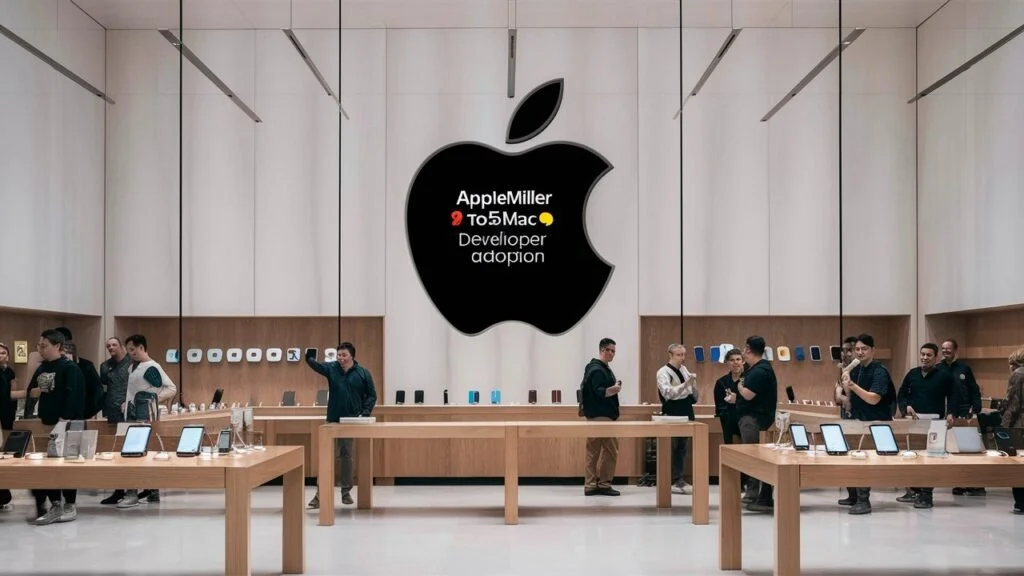Introduction to Apple Sign-In
In an increasingly interconnected digital world, where online security breaches and privacy violations are all too common, the necessity of robust authentication methods has never been more critical. Among the various solutions available, ‘Sign In with Apple’ stands out as a unique and secure gateway that fosters both user privacy and convenience. Launched by Apple, this feature allows users to sign in to third-party applications and websites seamlessly, using their Apple ID without having to disclose personal information.
At its core, ‘Sign In with Apple’ offers a streamlined login process. Users can authenticate their identity with a simple touch or facial recognition, depending on their Apple device capabilities. This ease of access is complemented by a strong emphasis on security. Apple provides users with the option to hide their email addresses, allowing them to maintain their privacy when accessing various services. This innovative approach addresses growing concerns over data breaches, as users are less likely to share sensitive information.
Moreover, as digital interactions continue to proliferate across multiple platforms, a secure sign-in option is essential to protect personal data from unauthorized access. The significance of ‘Sign In with Apple’ lies not only in enhancing user experience but also in safeguarding sensitive information against potential threats. Its integration into various applications signifies a robust move towards a more privacy-conscious digital ecosystem. This section serves as a foundation for a deeper exploration of the features and benefits associated with ‘Sign In with Apple,’ illustrating its pivotal role in modern digital security practices.
What is Apple Sign-In?
Apple Sign-In is a secure authentication feature that enables users to log into various applications and websites effortlessly using their Apple ID. This innovative method provides an alternative to traditional login processes, enhancing user experience by simplifying the authentication steps required to access digital services. By leveraging Apple’s robust privacy measures, Apple Sign-In prioritizes user security without compromising convenience.
One of the key attributes of this feature is its commitment to user privacy. When signing in with Apple, users have the option to conceal their email addresses from developers. Instead, Apple generates a unique, random email address that forwards communication to the user’s actual email. This functionality not only protects personal information but also allows users to maintain control over their data, thereby diminishing the risk of unsolicited marketing and spam.
In addition to its privacy features, Apple Sign-In seamlessly integrates across all Apple devices. Users can initiate a secure login across iPhones, iPads, and Macs using their Apple ID credentials. Furthermore, the login process employs Face ID or Touch ID, providing an additional layer of security while ensuring rapid access to applications and services. Developers can effortlessly implement this feature in their apps, catering to a growing demand for secure authentication methods that respect user privacy.
With its emphasis on user-centric design and security, Apple Sign-In emerges as a vital tool in the authentication landscape, appealing to both users and developers who value privacy and efficiency. As digital platforms continue to evolve, the need for secure and user-friendly sign-in methods like Apple Sign-In will undoubtedly remain crucial in fostering trust and safety in the digital realm.
Key Features of Apple Sign-In
Apple Sign-In, introduced as part of Apple’s privacy-centric approach, offers a series of standout features designed to enhance user experience while ensuring robust security measures. One of the key attributes is the Private Email Relay feature. This functionality allows users to sign in to third-party apps without revealing their personal email addresses. Instead, Apple generates a unique, random email address that forwards any messages to the user’s actual email. This approach not only protects personal information but also helps mitigate spam, enhancing the overall privacy of users.
Another significant feature is the Simplified Authentication. With Apple Sign-In, users can quickly authenticate their identity using their Apple ID, which typically requires just a tap or a Face ID/Touch ID confirmation. This streamlined process reduces the friction often experienced with traditional account creation methods, where users are required to input extensive information and create passwords. The ease of logging in and registering for apps using Apple’s biometric credentials significantly improves the user experience, encouraging more users to engage with various applications without the headaches associated with forgotten passwords.
The built-in security measures are also noteworthy. Apple implements advanced encryption methodologies, including two-factor authentication, making it challenging for unauthorized individuals to access user accounts. This level of protection is particularly appealing in an era where data breaches and privacy concerns are rampant. Moreover, Apple maintains a strict policy regarding user data, ensuring that personal information is not exploited or resold to advertisers. Such features collectively position Apple Sign-In as a trustworthy solution for both users and developers, as it fosters confidence in the way that data is handled and safeguarded.
Insights from Applemiller

As the digital landscape evolves, the importance of secure authentication mechanisms becomes more apparent. Applemiller offers valuable insights into the adoption of ‘Sign In with Apple,’ emphasizing its role as a trustworthy authentication solution. With growing apprehension regarding online privacy, users increasingly prefer platforms that prioritize their data security. This preference has, in turn, affected developers’ approaches, encouraging them to integrate ‘Sign In with Apple’ into their applications.
From Applemiller’s observations, developers recognize that implementing this authentication method enhances user trust due to Apple’s longstanding reputation for safeguarding user privacy. By leveraging Apple’s secure sign-in option, developers can alleviate user concerns regarding data breaches and third-party tracking. This insight is crucial, as many users are now more selective about the services they engage with, favoring those that demonstrate a commitment to safeguarding their information. Applemiller highlights that integrating ‘Sign In with Apple’ not only aligns with user expectations but also reflects a broader industry trend toward prioritizing user privacy in authentication processes.
Moreover, businesses adopting this tool have reported tangible benefits, including increased user engagement and conversion rates. By streamlining the sign-in process through a trusted platform, developers reduce friction, enabling users to access services effortlessly. As suggested by Applemiller, this ease of access is pivotal in retaining users in a highly competitive market. Consequently, integrating ‘Sign In with Apple’ has emerged not just as a technical choice but also as a strategic business decision. The insights from Applemiller underline the mutual advantages for developers and users, reaffirming the importance of privacy-centric solutions in today’s app development landscape.
Insights from 9to5mac
In recent discussions concerning online security and user privacy, 9to5mac has offered a comprehensive analysis of Apple’s “Sign In with Apple” feature. This service has emerged as a frontrunner when placed alongside other popular social login options such as Facebook and Google. The platform highlights critical aspects of data privacy, showcasing how Apple’s approach differs significantly from the conventional methods offered by tech giants. Unlike other social login mechanisms that often require the sharing of user data for functionality, Apple’s solution emphasizes minimal data transfer, making it appealing to privacy-conscious users.
The primary advantage of ‘Sign In with Apple’ is its focus on user anonymity. This method allows individuals to create accounts without revealing their email addresses, instead generating unique, random identifiers linked to a user’s Apple ID. Such implementations significantly mitigate the risks associated with data breaches and unwanted information sharing, as users retain greater control over their privacy. As highlighted by 9to5mac, this innovative approach not only enhances security but also fosters user trust, an essential aspect in today’s digital landscape.
Furthermore, the 9to5mac analysis brings to light Apple’s commitment to transparency and security within its ecosystem. With the increasing prevalence of data misuse in various technological spheres, users are leaning towards platforms that prioritize their privacy. The platform effectively illustrates that ‘Sign In with Apple’ is not merely a convenience but a fundamental redesign of how user authentication can be approached. As such, this solution addresses growing concerns over data ownership and privacy, establishing a secure gateway that resonates with users seeking dependable and efficient login alternatives.
Benefits of Using Apple Sign-In
Implementing ‘Sign In with Apple’ presents a host of benefits that enhance user experience while prioritizing privacy and security. One of the primary advantages is the commitment to user privacy. Unlike traditional logging methods, which often require excessive personal information, Apple Sign-In minimizes data sharing. Users can choose to hide their email addresses, allowing the application to generate a randomized email that forwards to their actual inbox, thereby reducing the risk of spam and protecting personal details.
Convenience is another significant benefit associated with this login method. With a single touch or a glance for Face ID, users can effortlessly access multiple apps without the hassle of managing numerous passwords and usernames. This streamlined process not only simplifies the login experience but also minimizes the chances of forgetfulness that can accompany numerous logins.
Furthermore, the cross-platform compatibility of Apple Sign-In enhances its appeal. While primarily associated with Apple devices, it allows users to utilize their Apple ID on non-Apple apps and services as well, reaching a broader audience. This level of integration across platforms encourages developers to adopt this technology, knowing it can cater to a wider user base.
Another crucial aspect is the enhanced security measures integrated within Apple Sign-In. It leverages two-factor authentication to protect users and significantly reduces the chances of unauthorized access. As cyber threats become increasingly sophisticated, adopting more secure login methods is essential, and Apple Sign-In stands out in this regard.
Overall, the choice to use Apple Sign-In aligns with a modern approach to digital identity, proving beneficial in terms of privacy, convenience, cross-platform accessibility, and security. These attributes collectively illustrate why many users are gravitating towards this innovative login solution.
How to Use Apple Sign-In

Using Apple Sign-In is a straightforward process that enhances both convenience and security when accessing apps or websites. To employ this feature, first look for the “Sign in with Apple” option on the login page of the application or website you are attempting to access. This option is usually situated alongside other sign-in methods such as Google or Facebook. By selecting this option, you initiate the authentication process.
Once you click on the “Sign in with Apple” button, you will be prompted to enter your Apple ID and password. Should you have two-factor authentication enabled on your account, you will receive a verification code on your trusted device, which you will need to enter to complete the sign-in process. This added layer of security is one of the key benefits of using Apple Sign-In, ensuring that your identity is well-protected.
After authenticating your identity, some apps may allow you to customize the information you wish to share. For instance, you may choose to share your email address or create a unique, random email address to protect your personal email from being disclosed. This feature not only enhances privacy but also prevents unwanted spam and marketing communications.
It is essential to note that not all apps provide the same level of customization. Some may require your real name, while others may offer greater flexibility. Therefore, carefully reviewing the permissions both before and after signing in is advisable. Once you have configured your settings, you can proceed, and your Apple ID will securely connect you to the app or website.
This simple yet effective method, “Sign in with Apple,” allows users to enjoy the benefits of easy access without compromising on security or privacy.
(FAQs)
As more users and developers consider integrating “Sign In with Apple” into their applications, several common questions arise. Below, we address some of the most frequent queries regarding this secure authentication method.
Q1. Is there a cost associated with “Sign In with Apple”?
No, utilizing “Sign In with Apple” is free for both users and developers. Developers can integrate this feature into their applications without incurring any additional fees. However, note that standard Apple Developer Program costs may apply.
Q2. Can “Sign In with Apple” be used on non-Apple devices?
Yes, “Sign In with Apple” is designed to be compatible with non-Apple devices. As long as the application is developed with the framework that supports Apple’s authentication method, users can log in from their Android devices or web browsers. This cross-platform functionality enhances user accessibility and ensures a broader reach for developers.
Q3. How does Apple protect my data when using this sign-in method?
Apple has implemented several measures to safeguard user data during the sign-in process. “Sign In with Apple” employs two-factor authentication to enhance security further. When using this service, users have the option to hide their email addresses, allowing them to maintain privacy while still receiving communications from the app. Apple does not track users’ sign-in activities or associate their identities with their usage.
Q4. How can I revoke access to apps using “Sign In with Apple”?
If you wish to revoke access for an app you have logged into using “Sign In with Apple,” navigate to your Apple ID settings. Under the “Privacy” section, you can manage app permissions, allowing you to easily remove any app’s access to your account.
Q5. What are the developer requirements for implementing “Sign In with Apple”?
Developers must be enrolled in the Apple Developer Program to use this feature. Additionally, they need to follow Apple’s guidelines for integrating the sign-in service into their applications, ensuring compliance with security protocols and user experience standards.
Conclusion
In today’s digital landscape, maintaining user privacy and security is of paramount importance. The introduction of the ‘Sign In with Apple’ feature stands as a significant advancement in safeguarding personal information while providing a seamless access experience. This innovative login solution not only simplifies the process of signing in to various applications and services but also employs cutting-edge privacy measures that prioritize user security. By permitting users to sign in with their Apple ID, this option eliminates the need to remember multiple passwords, effectively reducing the risk of unauthorized access.
A significant aspect of ‘Sign In with Apple’ is its ability to shield users from potential data breaches. This feature allows individuals to mask their email addresses when signing into apps, ensuring that their personal details remain confidential. Additionally, Apple does not track users’ activity across apps, reinforcing a commitment to user privacy that is increasingly rare in today’s tech environment. The valuable insights provided by sources like Applemiller and 9to5mac underline the effectiveness of this feature as a privacy-centric solution.
Considering the increasing prevalence of cyber threats, adopting ‘Sign In with Apple’ can be a prudent decision for both users and developers. By integrating this feature into their applications, developers not only enhance user trust but also comply with growing expectations regarding data privacy. As online interactions continue to evolve, embracing solutions that prioritize secure access like ‘Sign In with Apple’ will be essential for a safer digital experience. Therefore, it is advisable for individuals and businesses alike to consider adopting this login feature, thereby contributing to an ecosystem that values both convenience and the utmost regard for privacy.




